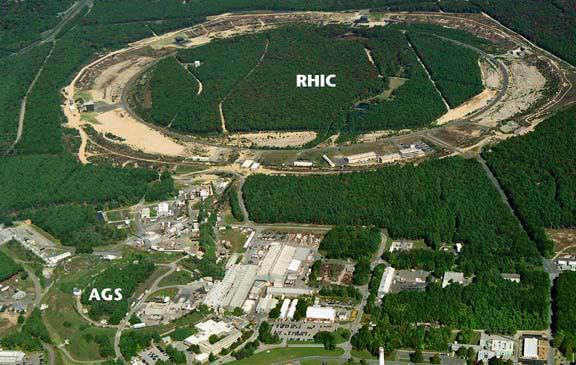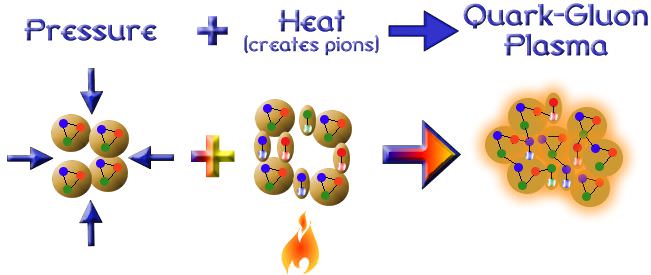The most powerful operational heavy-ion collider in the world, the Relativistic Heavy Ion Collider (RHIC) recently recorded the highest ever temperature created in an Earth-based laboratory of 4 trillion Kelvin. Achieved at the almost speed of light collision of gold ions, this resulted in the temporary existence of quark-gluon soup – something first seen at about ten to the power of minus twelve of the first second after the big bang.
And sure, the Large Hadron Collider (LHC) may one day soon be the most powerful heavy-ion collider in the world (although it will spend most of its time investigating proton to proton collisions). And sure, maybe it’s going to generate a spectacular 574 TeV when it collides its first lead ions. But you have to win the game before you get the trophy.
To give credit where it’s due, the LHC is already the most powerful particle collider in the world – having achieved proton collision energies of 2.36 TeV in late 2009. And it should eventually achieve proton collision energies of 14 TeV, but that will come well after its scheduled maintenance shutdown in 2012, ahead of achieving its full design capabilities from 2013. It has already circulated a beam of lead ions – but we are yet to see an LHC heavy ion collision take place.
So, for the moment it’s still RHIC putting out all the fun stuff. In early March 2010, it produced the largest ever negatively charged nucleus – which is anti-matter, since you can only build matter nuclei from protons and/or neutrons which will only ever have a positive or a neutral charge.
This antimatter nucleus carried an anti-strange quark – which is crying out for a new name… mundane quark, conventional quark? And since the only matter nuclei containing strange quarks are hypernuclei, RHIC in fact created an antihypernucleus. Wonderful.
Then there’s the whole quark-gluon soup story. Early experiments at RHIC reveal that this superhot plasma behaves like a liquid with a very low viscosity— and may be what the universe was made of in its very early moments. There was some expectation that melted protons and neutrons would be so hot that surely you would get a gas – but like the early universe, with everything condensed into a tiny volume, you get a super-heated liquid (i.e. soup).

The LHC hopes to deliver the Higgs, maybe a dark matter particle and certainly anti-matter and micro black holes by the nano-spoonful. And after that, there’s talk of building the Very Large Hadron Collider, which promises to be bigger, more powerful and more expensive.
But if that project doesn’t fly, we can still ramp up the existing colliders. Ramping up a particle collider is an issue of luminosity, where the desired outcome is a more concentrated and focused particle beam – with an increased energy density achieved by cramming more particles into a cross section of the beam you are sending around the particle accelerator. Both RHIC and the LHC have plans to undertake an upgrade to achieve an increase of their respective luminosities by up to a factor of 10. If successful, we can look forward to RHIC II and the Super Large Hadron Collider coming online sometime after 2020. Fun.


This antimatter nucleus carried an anti-strange quark – which is crying out for a new name…
These things are found in quark-gluon soup. They ought to be ‘croutons’.
.
This will be in interesting future development. In particular it might test theories of AdS/QCD duality, which is a lower dimensional version of the CFT/AdS correspondence.
LC
Um, technically an anti-strange ought to be as down with strangeness as a strange. Just “anti”.
(But I like “croûtons”. Can’t we just change anyway!?)
So. This QGP stuff is viscosity-less, isn’t it? If so, it is a super-fluid. “Super-heated super-fluid”, “antihypernucleus”; seems we are running out of superlatives. And we are still a ways to go to the Truly Terrific And So On Big Bang.
Therefore I propose a Superlative Naming Algorithm. The prefix is handled in the usual manner: QGP = super-heated super-liquid = (super)^2 heated liquid. And so on and so forth to the (super^n | n -> oo) big bang.
[You _could_ introduce convenient shorthands here. “Hyper” is already taken. Maybe super^2 is “super-duper”?]
Awaiting the next generation of super^3 stuff.
There is a correspondence of sorts between quark physics and string/M-theory. Strings are similar to mesons, where an open string with its endpoints, or Chan-Paton factors, are similar to a QCD gluon flux tube with quarks at the end. The string attaches as well to what are called Dp-branes which have topological charges. These charges can define so called other universes in what is called the multiverse. We can’t directly observe these other spacetime cosmologies, or universes. The issue is similar to detecting an isolated quark in QCD, which can’t be done. Yet the existence of quarks is inferred through the physics of hadron scattering, and the sorts of channels or amplitudes detected. The matter of the multiverse, a term that I frankly do not like, is that QCD is an elementary example of a field theory with a correspondence with AdS spacetime. This involves M-theory or Dp-branes which couple to strings. Dp-branes are “defects” of sorts with solitonic physics, and these define the physics of extended spacetime objects, such as the anti-de Sitter spacetime. At sufficiently high energy the channel effects scale as ~ const*log(?/E), so even at the TeV range in energy some stringy signatures should be apparent. This is particularly where a type IIB string which ties D3-branes together in an AdS setting transition into closed strings. From an experimental perspective there will then be the growth of certain scattering amplitudes which are reflected in this physics and this “stringy-braney” structure inferred — along with the mulitverse.
It is the case that our connection to physics and cosmology is becoming increasingly oblique. There appears to be no escape from this, as our astronomical observations take us out onto scales of extreme distances, while on the other we have to infer physics at a string scale from detection of particle production many orders of magnitude larger. In the case of the cosmos we have to construct a ladder of scales, Cepheid variables to get galaxy distances and v = Hd Hubble relations, redshift data further out to get commoving galaxies further out, SNI data beyond that and … . This may be far more the case, particularly if Tegmark’s multiverse level IV is real, where there is whole meta-class of cosmic structures which obey entirely different mathematical principles. It is unclear how we can ever test that. Sadly we may ultimately lose our grip on understanding physics and cosmology, but we might be able to unify quantum theory with gravity along with gauge fields to at least get some first order understanding of things. This appears to require the multiverse.
LC
Puts it into prospective; thanks for that LC.
I liked croutons – thanks all for reading my humble post.